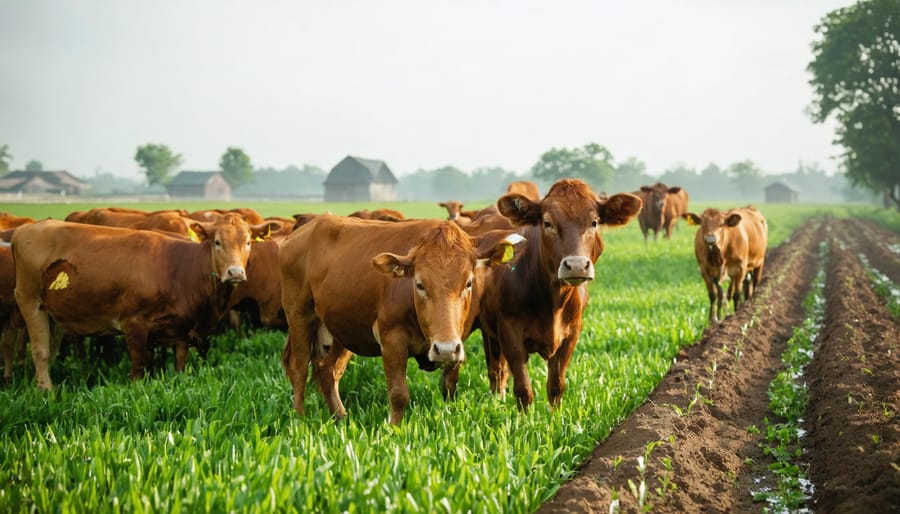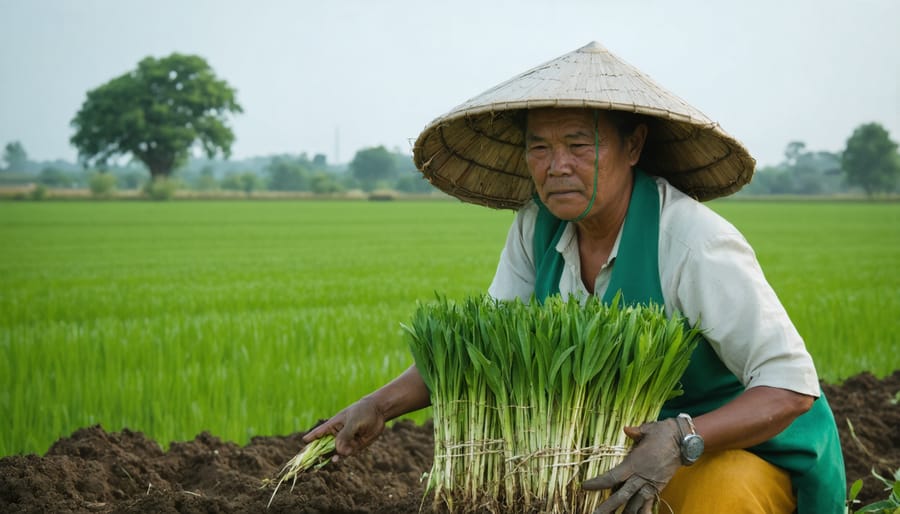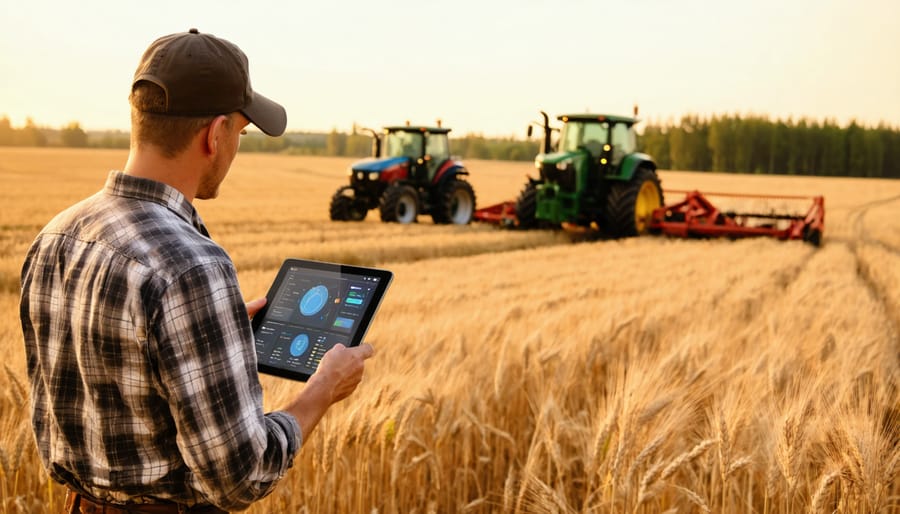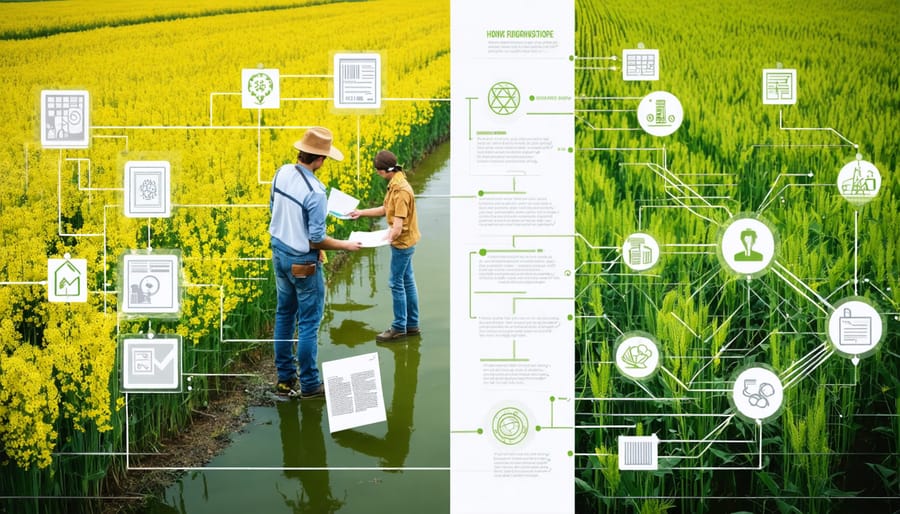Build trust with multilingual farming communities by implementing a structured language access plan that removes barriers to essential agricultural education and resources. Canada’s agricultural sector increasingly depends on diverse linguistic communities—from Punjabi-speaking greenhouse operators in Alberta to French-speaking grain farmers in rural regions—yet many extension programs still operate exclusively in English, limiting their reach and impact.
A comprehensive language access plan ensures your agricultural programming serves all farmers effectively, regardless of their primary language. This framework directly supports sustainable farming success by connecting evidence-based practices with the producers who need them most.
The five essential sections create a roadmap for meaningful inclusion: identifying your multilingual audience through demographic analysis and community engagement, evaluating current language services to find gaps, implementing practical translation and interpretation solutions within realistic budgets, training staff to work effectively across language barriers, and measuring your plan’s impact through feedback and participation metrics.
Agricultural educators implementing these plans report stronger attendance at workshops, increased adoption of sustainable practices, and deeper community relationships. A rural Alberta extension office serving South Asian farmers saw program participation increase by 63 percent after introducing Punjabi interpretation services and translated crop management guides.
This practical approach respects your organization’s resource constraints while prioritizing equitable access. Each section offers actionable strategies tested in real Canadian agricultural contexts, moving beyond compliance requirements toward genuine community partnership and enhanced learning outcomes for all producers.
What a Language Access Plan Actually Does for Your Agricultural Program
A language access plan is a strategic document that outlines how your agricultural program will communicate with and serve farming communities whose primary language isn’t English. Think of it as your roadmap for breaking down language barriers that might prevent farmers from accessing valuable education and resources.
In agricultural education, these plans matter because knowledge sharing literally affects whether crops thrive or fail. When a farmer misunderstands pest management timing or soil amendment ratios due to language barriers, the consequences impact their livelihood directly. A well-implemented language access plan ensures that all farmers in your community can participate fully in effective agricultural workshops, understand critical growing season updates, and access emergency information about weather events or disease outbreaks.
The benefits extend both ways. For program providers, language access planning increases workshop attendance, builds trust within diverse farming communities, and maximizes the return on your educational investment. For farmers, it means receiving information they can actually use, connecting with peers, and feeling genuinely welcomed into agricultural networks.
A compelling example comes from a rural Alberta extension program that implemented a basic language access plan targeting their growing Punjabi-speaking farming community. Before the plan, their soil health workshops averaged 12 participants. After adding Punjabi interpretation services and translating key handouts, attendance jumped to 34 participants within one growing season. More importantly, follow-up surveys showed that 89 percent of Punjabi-speaking attendees implemented at least one new practice from the workshop, compared to 62 percent previously.
The plan doesn’t need to be complicated. Even small steps like providing bilingual signage, partnering with community interpreters, or creating pictorial guides can dramatically improve access. The key is having a structured approach that identifies your community’s specific language needs and matches them with realistic, sustainable solutions that fit your program’s capacity and budget.

Section 1: Identifying Your Community’s Language Needs
Practical Assessment Methods for Rural Communities
Understanding who needs language support in your agricultural community starts with practical assessment methods that respect rural realities. Begin with simple community surveys distributed at farmers’ markets, agricultural supply stores, and local feed mills where producers naturally gather. These surveys should ask straightforward questions about preferred languages for receiving information and current barriers to accessing agricultural education programs.
Partner with local settlement agencies who work directly with newcomer farmers. These organizations maintain valuable data about language demographics and can facilitate introductions to farming families who might benefit from translated resources. In Alberta, organizations like the Calgary Catholic Immigration Society and Edmonton Mennonite Centre for Newcomers regularly connect with agricultural newcomers.
Agricultural organizations offer another assessment pathway. Connect with commodity groups, 4-H clubs, and rural municipalities to identify language patterns within their membership. County agricultural fieldmen often have firsthand knowledge of linguistic diversity in their regions.
Consider conducting informal kitchen table consultations where multilingual farm families feel comfortable sharing their experiences. These conversations reveal not just language preferences but also cultural considerations for effective communication.
Document your findings using a simple spreadsheet tracking languages spoken, geographic concentration, and specific program areas where translation needs are greatest. This baseline data becomes essential for prioritizing translation resources and measuring progress as your language access plan develops.
Questions to Ask During Your Assessment
Gathering accurate information from your farming community requires asking the right questions. Start with language identification: “What is your preferred language for receiving agricultural information?” and “Are there other languages spoken in your household?” This helps you understand the full linguistic landscape.
Assess literacy levels respectfully by asking, “How do you prefer to receive information: written materials, videos, in-person demonstrations, or audio recordings?” This indirect approach reveals communication preferences without making anyone uncomfortable. For multilingual farmers, ask “Do you feel comfortable reading technical information in English, or would you prefer it in your first language?”
Understanding technology access is crucial in rural areas. Include questions like “What devices do you regularly use to access information?” and “Do you have reliable internet at your farm operation?” Consider that many Alberta producers have limited connectivity, affecting digital learning options.
Timing matters too. Ask “What time of year are you most available for training?” and “What time of day works best for your schedule?” Harvest seasons and daily farm routines vary significantly across different cultural farming practices.
Finally, inquire about existing support systems: “Do you have family members or community members who help translate information for you?” This reveals valuable resources and potential volunteer translators within your agricultural community.
Section 2: Building Your Translation and Interpretation Resources
Prioritizing What to Translate First
Not all documents need immediate translation, and smart prioritization helps you use your resources effectively. Start by identifying materials that directly impact safety, legal compliance, or program participation. These are your critical translations.
In agricultural education, priority documents typically include pesticide safety information, equipment operation manuals, emergency procedures, and registration forms. When Alberta’s Olds College expanded their sustainable agriculture workshops, they began with safety protocols and program enrollment materials before tackling supplementary resources.
Consider the consequences of not translating each document. If someone can’t safely operate machinery or understand chemical handling procedures because of language barriers, that’s an immediate risk. Compare this to promotional materials or general interest articles, which can wait.
A practical approach is creating three tiers. Tier one includes safety information, legal notices, and essential program access forms. Tier two covers core educational materials like workshop handouts and curriculum guides. Tier three encompasses newsletters, social media content, and supplementary resources.
Talk with your multilingual community members about what matters most to them. During a recent focus group with Punjabi-speaking farmers in the Fraser Valley, coordinators discovered that loan application assistance and crop insurance forms were higher priorities than initially assumed. This direct feedback ensures your translation efforts address real needs rather than assumptions.

Finding Qualified Agricultural Interpreters
Finding qualified agricultural interpreters requires looking beyond general language services to individuals who understand the nuances of farming terminology. Start by connecting with agricultural extension offices, farm organizations, and immigrant settlement agencies across Alberta. These groups often maintain networks of bilingual community members with farming backgrounds who can bridge both language and knowledge gaps.
Subject-matter expertise matters significantly in agricultural settings. An interpreter who understands crop rotation, livestock management, or food safety protocols will communicate more accurately than someone with general language skills alone. Consider reaching out to agricultural colleges like Olds College or Lakeland College, where international students and bilingual graduates may offer interpretation support.
Working effectively with bilingual community members means treating them as valuable partners, not just translators. Provide them with materials in advance so they can research unfamiliar terms. Offer fair compensation that reflects their specialized knowledge. Many successful Alberta programs have found that experienced farmers who speak multiple languages make exceptional interpreters because they can explain concepts using culturally relevant examples.
Building relationships with several interpreters creates flexibility for different events and languages. Document their contact information, language pairs, and agricultural specialties in your language access plan. This roster becomes an invaluable resource as your programming grows and serves increasingly diverse farming communities across the region.
Digital Tools That Actually Help
Translation apps like Google Translate work well for simple farm safety signs or basic instructions, but they fall short with agricultural terminology. A Saskatchewan grain cooperative learned this when automated translation confused “pest management” with “annoying person management” in their Punjabi materials.
For straightforward documents like meeting schedules or event notices, digital tools save time and money. Many Alberta farm organizations successfully use DeepL or Microsoft Translator for initial drafts of newsletters and announcements. However, always have a bilingual community member review the output before distribution.
Human translation remains essential for critical situations including pesticide application instructions, veterinary protocols, food safety certifications, and legal documents like land lease agreements. The cost difference matters less when miscommunication could result in crop loss or safety incidents.
Consider a hybrid approach that stretches your budget: use technology for initial translation, then invest in professional review for technical accuracy. Several Alberta agricultural extension offices partner with local multicultural centres to access qualified translators who understand both farming practices and cultural context, creating more reliable resources for their diverse farming communities.
Section 3: Training Your Team on Language Accessibility
Cultural Competency for Agricultural Educators
Cultural competency training forms the foundation of effective agricultural education across language barriers. For agricultural educators working with Alberta’s diverse farming communities—including Francophone, Indigenous, and newcomer farmers—understanding communication differences goes far beyond simple translation.
Start by recognizing that communication styles vary significantly across cultures. Some farming communities prioritize direct, concise instruction, while others value context-rich storytelling and relationship-building before diving into technical content. Dr. Maria Santos, an extension educator in southern Alberta, observed that many Filipino greenhouse workers initially hesitated to ask questions during workshops, not due to language barriers, but because their cultural norms emphasized learning through observation rather than verbal inquiry.
Avoid assumptions about literacy levels, prior agricultural knowledge, or technological comfort. A Ukrainian farmer with decades of grain farming experience may possess extensive knowledge that doesn’t directly translate to Canadian organic certification requirements. Similarly, don’t assume younger participants are automatically comfortable with digital learning platforms.
Practical training should include learning to read non-verbal cues indicating confusion or disengagement. Implement adapting teaching methods that accommodate various learning preferences: visual demonstrations, hands-on practice, small group discussions, and written materials in multiple formats.
Establish a peer mentorship program where experienced multilingual farmers support newer community members. The Manitoba Farming Connections program successfully pairs newcomer farmers with established producers who share linguistic backgrounds, creating culturally relevant learning pathways while building community resilience.
Regular cultural competency refresher sessions help educators stay current with evolving community demographics and continuously improve their inclusive teaching practices.
Working Effectively with Interpreters in Workshop Settings
Successfully working with interpreters requires adjusting your delivery approach to ensure everyone comprehends the material. Start by speaking in shorter segments, ideally 2-3 sentences at a time, then pause for interpretation. This pacing allows interpreters to convey your message accurately while maintaining the natural flow of information.
Before your workshop begins, meet with interpreters to review technical agricultural vocabulary. Terms like “nitrogen fixation,” “crop rotation cycles,” or “soil aggregation” need precise translation. Consider providing interpreters with glossaries or visual aids beforehand. One Alberta extension coordinator shared how creating a bilingual reference sheet for their soil health workshop prevented confusion when translating “tilth” into Spanish and Punjabi.
Use visual supports extensively. Charts, diagrams, and photos communicate across language barriers and help interpreters clarify complex concepts. When discussing measurements, always use metric standards familiar to Canadian audiences and repeat key numbers for accuracy.
Position yourself to see both the interpreter and participants. This visibility helps you gauge comprehension and adjust your pace accordingly. Allow extra time in your agenda—interpreted workshops typically require 30-40 percent more time than single-language sessions.
Finally, encourage questions through interpreters and build in frequent check-ins to confirm understanding. Creating this inclusive environment ensures all participants gain practical knowledge they can implement on their operations.

Section 4: Implementing Communication Protocols and Procedures
Creating Multilingual Communication Channels
Effective communication channels form the backbone of your language access plan. Start by designating a multilingual contact point—this could be a dedicated phone line with language routing options or a bilingual staff member who coordinates language support requests. For Alberta producers, consider partnering with organizations like the Alberta Association of Immigrant Serving Agencies to establish reliable interpretation services.
Implement a clear email protocol where farmers can indicate their preferred language in the subject line, triggering automatic routing to appropriate language support staff or translation services. Include language preference options in all registration forms and contact databases to ensure consistent follow-up in the right language.
In-person support remains crucial for building trust with multilingual farming communities. Schedule regular office hours with interpreters present, or arrange mobile support visits to farms where language barriers exist. One successful Alberta case study involved an agricultural extension office partnering with local settlement services to host monthly multilingual clinics, serving Punjabi, Spanish, and French-speaking producers.
Create visual guides showing how to access each communication channel, using universal icons alongside minimal text in multiple languages. Post these prominently in cooperative offices, community centres, and agricultural supply stores. Track which channels farmers prefer most, allowing you to allocate resources effectively while ensuring no producer faces communication barriers when seeking agricultural guidance.
Documentation Standards
Clear documentation standards keep your multilingual materials consistent and reliable across your agricultural community. Start by identifying which materials require translation—prioritize essential documents like safety procedures, equipment operation guides, and program registration forms over nice-to-have content. For Alberta farming operations, this might include seasonal crop guides, irrigation schedules measured in litres per hectare, or livestock health protocols.
Establish a version control system that tracks updates across all language versions. When you revise your English winter wheat planting guide, ensure the Ukrainian and Spanish versions receive the same updates simultaneously. A simple spreadsheet tracking document names, languages, version numbers, and last update dates works well for smaller organizations.
Set quality benchmarks by working with qualified translators familiar with agricultural terminology—someone who understands the difference between seeding rates and germination rates in both languages. Consider partnering with local agricultural colleges or immigrant settlement organizations that may offer translation services.
Create a review process where bilingual community members or farmers verify that translated materials make practical sense. A Punjabi-speaking dairy farmer from Lethbridge reviewed translated milking protocols for one Alberta cooperative, catching technical errors that could have caused confusion. Document your translation workflow, including who approves materials, timelines for completing translations, and where finalized documents are stored for easy access by staff and community members.
Emergency and Time-Sensitive Information Protocols
When critical situations arise—like severe weather warnings, disease outbreaks in livestock, or urgent program changes—your multilingual farming community needs information immediately. Establish clear protocols before emergencies occur by identifying key information channels that reach diverse language groups effectively.
Start by creating a tiered communication system. Designate primary contacts within each language community who can quickly relay urgent messages. Alberta farmer Maria Gonzalez, who coordinates Spanish-language outreach for her region, suggests maintaining updated contact lists with preferred communication methods for each community member, whether that’s text messages, phone calls, or messaging apps like WhatsApp that many newcomer farmers already use daily.
Prepare template messages in all priority languages ahead of time for common scenarios: frost warnings, irrigation restrictions, pest alerts, and program cancellations. Store these pre-translated templates where staff can access them 24/7. Partner with professional translation services that offer rush services for unexpected situations.
Consider visual communication tools that transcend language barriers. Weather alert graphics with universal symbols, colour-coded risk maps, and infographic-style pest identification guides communicate essential information quickly. One Saskatchewan extension office reported 85 percent faster information uptake after implementing visual alert systems alongside translated text.
Test your emergency protocols annually with simulated scenarios to identify gaps before real crises emerge.
Section 5: Monitoring, Evaluating, and Improving Your Plan
Metrics That Matter in Agricultural Education
Tracking the right metrics helps you understand whether your language access efforts are truly reaching diverse farming communities. Start with participation rates broken down by language group – if your region serves Punjabi, Spanish, and French-speaking farmers, measure registration and attendance for each group separately. This reveals whether certain communities remain underserved.
Satisfaction scores matter too. After workshops or training sessions, ask participants in their preferred language how well they understood the content and whether translation quality met their needs. A simple 1-5 scale works effectively here.
Knowledge retention measurements tell you if language accessibility translates into actual learning. Consider follow-up surveys three months post-training asking farmers to describe one practice they implemented. Compare retention rates across language groups to identify gaps.
Olds College in Alberta tracks these metrics quarterly for their multilingual extension programs. Their data showed that while Punjabi participation reached 78% of the local farming population, knowledge retention lagged at 45% – prompting them to enhance written materials with visual guides.
Monitor resource utilization rates too: which translated materials get downloaded most, and which languages generate the most follow-up questions? These indicators guide future resource allocation, ensuring your language access plan evolves with community needs rather than assumptions.
Gathering Feedback from Multilingual Participants
Creating effective feedback systems helps you understand how well your language services meet participant needs. Anonymous surveys in participants’ preferred languages work particularly well, as farmers can share honest input without concern. Consider partnering with trusted community members who speak the languages represented in your programs to conduct informal listening sessions at farm markets or community centres.
The Manitoba Agricultural Services Corporation successfully gathers feedback by offering bilingual comment cards at workshop exits, with response rates increasing 40% after translation into French and Low German. Phone interviews conducted by multilingual extension staff provide another valuable option, especially for participants less comfortable with written surveys.
Time your feedback collection strategically – immediately after workshops and again three months later to assess long-term value. Ask specific questions about interpretation quality, written material clarity, and cultural appropriateness of examples used. Alberta’s Olds College found that offering small incentives, like seed packets or agricultural guides, increased survey completion rates among diverse farming communities.
Keep surveys short (under 10 questions) and include both rating scales and open-ended questions. This dual approach captures quantitative data for tracking improvements while allowing participants to share specific experiences and suggestions for enhancing your language access services.
Annual Review and Update Process
Your language access plan stays relevant when you review it annually and adjust based on real community changes. Set a specific month each year to assess your plan’s effectiveness—many Alberta agricultural organizations align this with fiscal planning in early spring. Survey participating farmers about language services they’ve used and needed, tracking attendance patterns at multilingual workshops and translation requests throughout the year.
Collect demographic data from local settlement agencies and agricultural extension offices to identify shifts in farming community composition. For example, Red Deer region coordinators discovered growing Punjabi-speaking populations through census updates and partnership consultations, prompting expanded translation services. Document what worked well and what didn’t—perhaps written materials were highly valued while interpretation services went underutilized, signaling budget reallocation opportunities.
Engage your community advisory committee in this annual process, seeking input from farmers who’ve accessed language services directly. Their frontline perspective reveals gaps you might miss. Update your language inventory based on emerging needs, adjust resource allocation accordingly, and revise protocols that proved ineffective. This cyclical approach ensures your plan grows alongside your community, maintaining meaningful access for all agricultural learners.
Making Language Access Work Within Your Budget
Language accessibility doesn’t have to break the bank for agricultural organizations. Many Canadian farming groups have found creative ways to serve multilingual communities while respecting tight budgets.
Start by maximizing free translation tools for basic written materials. Services like Google Translate work well for simple announcements and notices, though always have bilingual community members review for accuracy. The Alberta Association of Agricultural Societies offers guidance on cost-effective communication strategies that member organizations can adapt.
Consider volunteer interpreters from within your farming community. Many second-generation farmers are bilingual and willing to help translate workshops or field days. Create a language resource database of community members who can assist during key educational events. Offer these volunteers benefits like free workshop admission or priority registration for popular programs.
Explore partnership opportunities with settlement agencies and multicultural organizations. Groups like the Calgary Catholic Immigration Society and Edmonton Mennonite Centre for Newcomers often seek agricultural partners for newcomer farmer programs. These partnerships can provide professional interpretation services at reduced or no cost while connecting you with farmers eager to learn.
Alberta organizations should investigate the Community Initiatives Program, which funds projects promoting inclusive communities. The Alberta Real Estate Foundation also supports rural initiatives that could include language accessibility components. The Growing Forward 2 program has historically supported agricultural education projects with diversity components.
Consider the return on investment. Red Deer County’s multicultural farming workshops saw participation increase by 140 percent after implementing translation services, with participating farms reporting improved practices and yields. When newcomer farmers access your programs, they become productive community members who contribute to local agricultural economies.
Start small with one language representing your largest non-English speaking group. Pilot translation for your most popular workshop, measure attendance and feedback, then expand gradually. Technology like recorded video translations can be created once and reused multiple times, spreading costs across multiple growing seasons. The key is viewing language accessibility as an investment in community growth rather than merely an expense.
Creating a language access plan isn’t about checking a compliance box—it’s about opening doors to knowledge, building trust, and strengthening Alberta’s agricultural community. When producers from diverse linguistic backgrounds can fully participate in educational programs, everyone benefits. You gain richer discussions, diverse perspectives on problem-solving, and a more resilient farming network.
The beauty of implementing a language access plan is that you don’t need to tackle everything at once. Start with one section that addresses your community’s most pressing need. Perhaps that’s translating your most popular workshop materials, or maybe it’s training one staff member in basic interpretation coordination. Small steps create momentum.
Remember, language accessibility does more than transfer information—it builds relationships. When a Punjabi-speaking vegetable grower sees educational materials in their language, or when a Spanish-speaking ranch hand can ask questions in their first language, you’re communicating something powerful: you belong here, your success matters to us, and we’re committed to supporting you.
Alberta’s agricultural landscape is changing, with newcomer farmers bringing fresh ideas and energy to our sector. Your language access plan positions your organization to tap into this potential while supporting established producers navigating new linguistic realities on their operations.
The time to act is now. Choose one section from your plan and implement it this month. Your future participants—and the broader agricultural community—will thank you for it.










